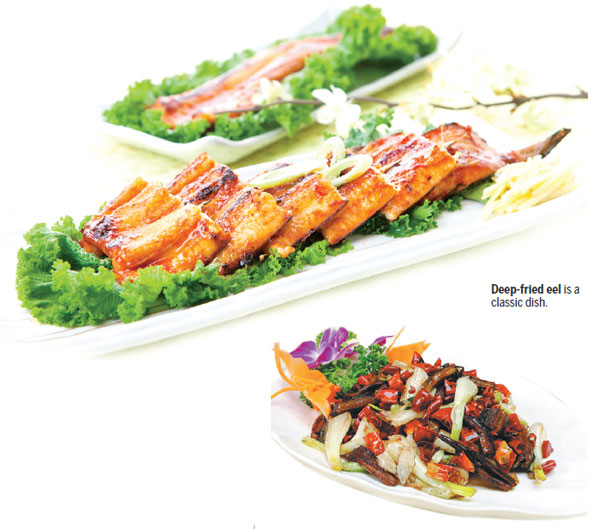A cool fish for summer

Traditional and fusion cooking styles, regional and international ingredients and a new awareness of healthy eating are all factors contributing to an exciting time for Chinese cuisine. Pauline D Loh explores the possibilities.
Summer is a trying season when it comes to both eating and cooking. As our thoughts drift to sunny days by the beach and excursions into the green countryside, the food images conjured up are of long cool drinks and baskets of sweet summer fruits.
That's why the ancients recommend certain ingredients for summer meals. These are "cooling" but nutritious foods for the hot sweaty days, when appetites wane and the digestive system prefers something light.
Eels. Little freshwater wrigglers that grow in swamps and rice fields and are otherwise known as huangshan, or yellow eels. These little fish are cool, according to Li Shizhen's Bencao Gangmu, the materia medica of traditional Chinese medicine.
The dark grey and gold, airbreathing scaleless fish have only a lone triangular backbone, unlike sea eels or river eels, which have hundreds of fine, tiny bones all over their bodies.
They are much smaller, too, and adult eels are only about 40 to 60 centimeters on average from head to tail. They are tenacious survivors and are often sold live, wriggling together in a basin in a slimy mass.
When I visited Shanghai many years ago, I saw eels being prepared by the fishmonger on my first visit to the market. They were covered with a slippery mucus and were pretty hard to handle. But they posed no challenge to the experienced fishmongers.
The eel was picked out and quickly dispatched with a swift stab to the head with a special pick. Pinned to the chopping board, the eel was then spliced open and its backbone stripped at a single stroke, leaving just the fillets.

The yellow eels are in season in early summer, when they are fattening up for the spawning season from June to August. This is the best time to enjoy them. They are now mostly farmed, and production is most abundant in the monsoonal regions in China's southern provinces.
There is an old culinary saying that in summer, the yellow eels have better nutrition than aged ginseng.
Their meat is full of fat and protein, calcium, potassium and various B vitamins, so there is sufficient scientific backing for that old adage.
To the Chinese, everything about this little eel has health benefits - bones, skin, blood and flesh. Li Shizhen even recommended reducing its head and bones to ash, mixing it with yellow wine and feeding the mixture to patients with gynecological complaints.
Its flesh is for those who are anemic but cannot afford to eat too much red meat. It is a panacea that is often prescribed for those who suffer from tinnitus or middle-ear infections, eczema, coughs or weak digestion, among other ailments.
There is one part of the eel that must be strictly avoided, though, and that is the slimy mucus it secretes. This toxic slime must be rubbed off with plenty of salt, and rinsed off thoroughly. The toxin breaks down with heat, so the eels must be cooked well to get rid of any stubborn residue.
There are many classic eel dishes that are popular on the summer menus of restaurants and homes all over China.
My hutong-raised husband says his family favorite is eel stir-fried with fresh green peppers. These are the spicy long green peppers that are eaten more as vegetables in Beijing. The stir-fry starts with finely sliced Beijing leeks and shredded ginger, then the shredded eel and green peppers go in the pan. The fish is finished with salt and a huge amount of cracked black pepper.
My first taste of eel was a dish steamed with lots of ginger and sweet yellow bean paste. The eels are cut into chunks and placed on a plate. The steaks are topped with a layer of finely minced ginger and yellow fermented bean paste diluted with sweet rice wine.
When the dish comes out of the steamer, it is immediately drizzled with hot peanut oil and sesame oil.
In Zhongshan, Guangdong province, a clay pot eel rice is the taste of home for many emigrants back to visit. The eels are blasted in hot oil, raw rice is added and then the mixture is transferred to clay pots. Long, slow cooking concentrates the fragrance and creates a golden crust of crunchy rice.
Of course, no one does eel better than the Shanghainese, who have made eel their regional specialty.
There is that iconic and delicious deep-fried eel, caramelized by the high heat, then coated with a thick sweet soy sauce. It has crunch in every bite.
And then there is the thick eel soup, shanhu, full of shredded eel, black woodear jelly fungus and bamboo shoots in a savory broth redolent with golden garlic, black pepper and minced Chinese celery.
Eel has to be heavily seasoned to get rid of its fishy pungency, and lots of pepper and ginger are used to counter its "cool" properties. The result is always delicious.
Contact the writer at paulined@chinadaily.com.cn
MOST POPULAR
- 1 China to continue opening up its mega-market to world: premier
- 2 Policies concerning expats, foreign enterprises in November 2025
- 3 China to enhance convenience for inbound tourism: minister
- 4 Departure tax refund applications surge 285% as inbound tourism rebounds
- 5 China's foreign trade up 3.6% in first 11 months of 2025







